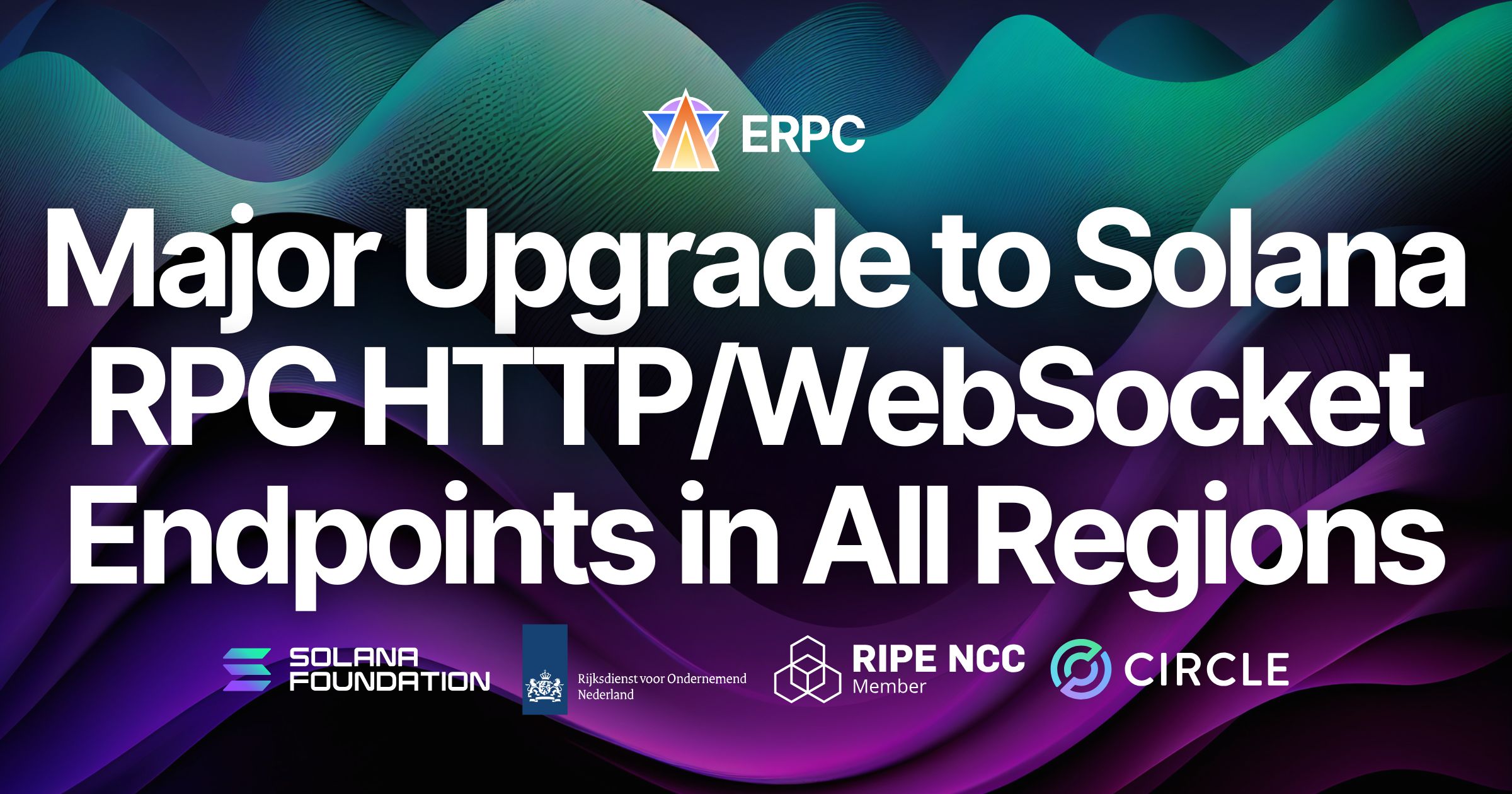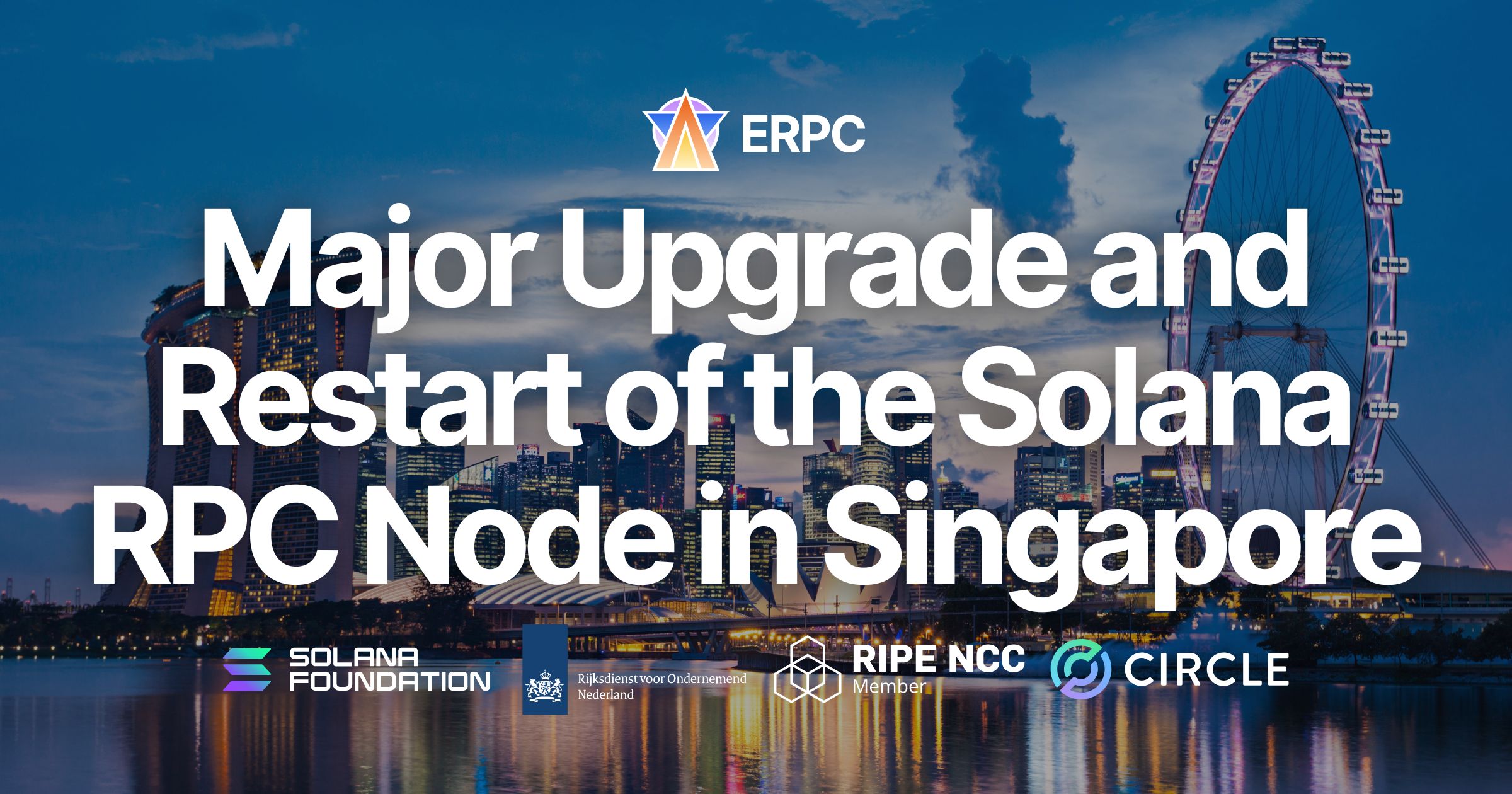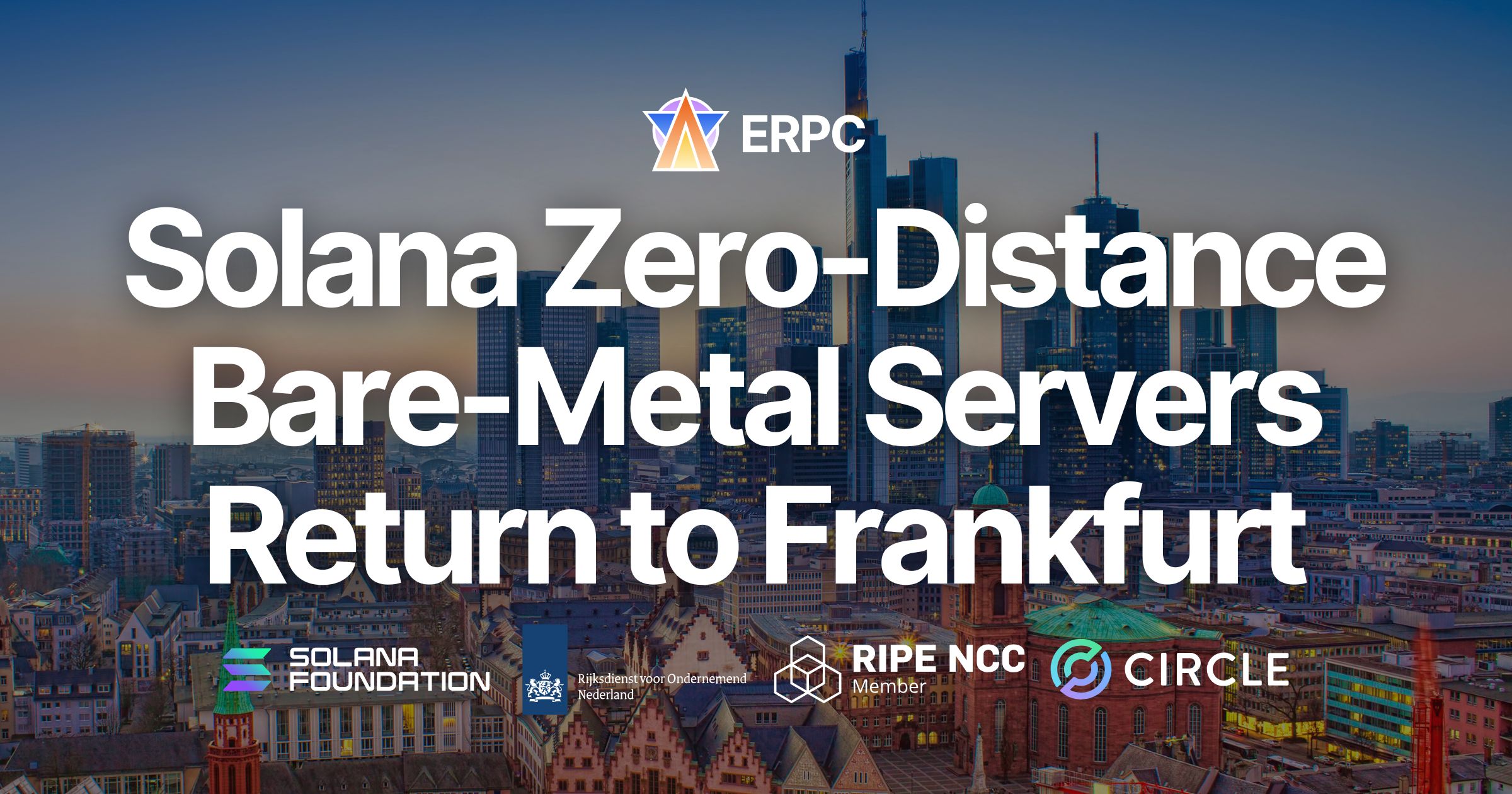ERPC Announces Major Upgrade to Solana RPC HTTP/WebSocket Endpoints Across All Regions, Improving Performance and Stability Through Network Optimization and Load Handling Enhancements
ERPC Announces Major Upgrade to Solana RPC HTTP/WebSocket Endpoints Across All Regions, Improving Performance and Stability Through Network Optimization and Load Handling Enhancements

ELSOUL LABO B.V. (Headquarters: Amsterdam, The Netherlands, CEO: Fumitake Kawasaki) and Validators DAO have implemented a large-scale network upgrade for ERPC’s Solana RPC HTTP/WebSocket endpoints across all regions, including Amsterdam, Frankfurt, London, New York, Chicago, Tokyo, and Singapore.
This upgrade involved a comprehensive set of improvements such as network optimization, enhanced defensive logic, load handling measures, node expansion, and Solana software updates. Together, these changes have resulted in significantly improved stability and lower latency, especially under high load.
In addition, rare instances of HTTP 500 errors observed during peak traffic have been greatly reduced, providing a more reliable environment for developers and dApp users.
In addition, rare instances of HTTP 500 errors observed during peak traffic have been greatly reduced, providing a more reliable environment for developers and dApp users.
Growing Global Demand for Solana and Challenges with Conventional RPC Deployment
With the approval of Solana ETFs and ongoing growth in new ETF products, global attention on the Solana ecosystem continues to rise.
However, traditional RPC providers have commonly deployed nodes only in a few core regions such as Frankfurt, Amsterdam, or New York, making it difficult for many areas—particularly across Asia—to access nearby, high-quality RPC endpoints.
However, traditional RPC providers have commonly deployed nodes only in a few core regions such as Frankfurt, Amsterdam, or New York, making it difficult for many areas—particularly across Asia—to access nearby, high-quality RPC endpoints.
In Asia, developers and users often had no choice but to connect to distant regions, resulting in latency exceeding hundreds of milliseconds in some cases.
For high-frequency trading applications or latency-sensitive dApps, this distance posed a major bottleneck.
For high-frequency trading applications or latency-sensitive dApps, this distance posed a major bottleneck.
Furthermore, without access to nearby high-performance RPC endpoints, developers found it difficult to test under conditions similar to production, leading to reduced development efficiency.
To address these issues, ERPC has continued expanding its global footprint and improving its technology to deliver a fast and stable Solana environment for developers and users worldwide.
ERPC’s Design Philosophy: Providing Globally Consistent, High-Performance Solana RPC
To ensure developers around the world can access Solana RPC with high speed and stability, ERPC operates HTTP/WebSocket nodes in seven regions: Amsterdam, Frankfurt, London, New York, Chicago, Tokyo, and Singapore.
ERPC’s global proxy automatically and intelligently routes each user to the nearest region, minimizing distance-induced latency variations.
This upgrade further advances that design philosophy by strengthening and equalizing performance across all HTTP/WebSocket endpoints.
This upgrade further advances that design philosophy by strengthening and equalizing performance across all HTTP/WebSocket endpoints.
Network Optimization and Enhanced Defensive Logic
This upgrade introduces improvements across both network routing and defensive layers:
- Improved global proxy routing accuracy for more stable lowest-latency paths
- Enhanced ping-based dynamic routing
- Reorganized nftables rule ordering and structure
- Early blocking of abnormal or suspicious traffic
- A refined ruleset that prioritizes legitimate traffic
These enhancements bolster defense capabilities while reducing processing overhead for normal traffic.
Load Handling and Node Expansion: Significant Reduction in HTTP 500 Errors
During peak traffic periods, rare instances of HTTP 500 errors previously occurred.
The following improvements have dramatically reduced these issues:
The following improvements have dramatically reduced these issues:
- Node expansion based on region-specific load characteristics
- Rebalancing of load distribution
- Adjustments to backend queue management and timeout configurations
- Routing control that reduces hotspot formation under heavy traffic
As a result, congestion-related stalls have been greatly reduced, and HTTP 500 errors have become far less frequent.
Requests now return 200-level responses more consistently, reducing application-level uncertainty for developers.
Requests now return 200-level responses more consistently, reducing application-level uncertainty for developers.
Regional Improvements
Tokyo Region
Among all regions, Tokyo saw the most dramatic improvement.
Latency and stability for users across Asia have significantly improved, greatly enhancing feasibility for high-frequency trading bots and latency-sensitive dApps.
Latency and stability for users across Asia have significantly improved, greatly enhancing feasibility for high-frequency trading bots and latency-sensitive dApps.
Europe (Amsterdam / Frankfurt / London)
Although already stable, these regions now show reduced variance during peak load, resulting in more consistent response times.
North America (New York / Chicago)
Load distribution and node configuration were refined based on regional traffic patterns, improving stability during peak hours.
Singapore
Following the major upgrade announced on the 21st, Singapore has also benefited from network optimization and strengthened defensive logic across the HTTP/WebSocket layer.
Position of SWQoS Endpoints and Network Path Improvements
SWQoS (Stake-Weighted Quality of Service) is a mechanism within the Solana network that prioritizes transaction delivery based on stake, ensuring that validators and stake-affiliated connections can reliably reach the leader even during congestion.
Alongside improvements to the HTTP/WebSocket network, we have also optimized the network paths used by SWQoS endpoints.
Thanks to overall network efficiency enhancements and strengthened defensive logic across ERPC’s infrastructure, SWQoS-based transaction delivery now operates with greater stability than before.
Thanks to overall network efficiency enhancements and strengthened defensive logic across ERPC’s infrastructure, SWQoS-based transaction delivery now operates with greater stability than before.
ERPC currently provides its SWQoS-enabled environment in the Frankfurt region, where its benefits are most pronounced during time periods when Frankfurt hosts the network leader.
All Nodes Upgraded to the Latest Solana Software Version
All RPC nodes providing HTTP/WebSocket services have been updated to the latest Solana software version, reflecting protocol-level optimizations and more stable log retrieval.
Combined with this upgrade’s network improvements, response speed and stability have improved across all regions.
Combined with this upgrade’s network improvements, response speed and stability have improved across all regions.
Solving Developer Pain Points: The Importance of Nearby High-Performance RPC
When developers must connect to distant RPC regions, testing under production-like conditions becomes difficult, leading to latent issues that only surface during live operation.
With this upgrade, developers can now rely on fast, nearby HTTP/WebSocket RPC endpoints, improving consistency between development and production environments.
With this upgrade, developers can now rely on fast, nearby HTTP/WebSocket RPC endpoints, improving consistency between development and production environments.
For developers in Asia especially, improvements in Tokyo and Singapore significantly enhance the development experience.
Benefits for dApp Users
User experience in dApps is heavily influenced by the quality of nearby RPC endpoints.
This upgrade allows users worldwide to connect to high-performance endpoints in their region, resulting in faster swaps, mints, gameplay interactions, and overall smoother UX.
This upgrade allows users worldwide to connect to high-performance endpoints in their region, resulting in faster swaps, mints, gameplay interactions, and overall smoother UX.
Error rates during busy periods have also decreased, contributing to greater application stability.
Challenges Addressed by ERPC, SLV, and Validators DAO
- Transaction failures and latency fluctuations common in many RPC environments
- Performance throttling and overcommitment by many infrastructure providers
- Significant impact of network distance on communication quality
- Difficulty for smaller teams to secure reliable, high-quality infrastructure
Our experience building the open-source Solana NFT card game Epics DAO highlighted severe challenges in obtaining fast and reliable RPC infrastructure.
Leveraging the expertise gained through this process, we now provide ERPC and SLV to support the broader Solana ecosystem.
Leveraging the expertise gained through this process, we now provide ERPC and SLV to support the broader Solana ecosystem.
In mission-critical domains such as finance, latency and errors directly affect user experience.
ERPC and Validators DAO will continue refining infrastructure in line with evolving Solana network requirements and global demand, contributing to better development and user experiences worldwide.
ERPC and Validators DAO will continue refining infrastructure in line with evolving Solana network requirements and global demand, contributing to better development and user experiences worldwide.
- ERPC Official Website: https://erpc.global/en
- SLV Official Website: https://slv.dev/en
- elSOL Official Website: https://elsol.app/en
- Epics DAO Official Website: https://epics.dev/en
- Validators DAO Official Discord: https://discord.gg/C7ZQSrCkYR



